
A machete is a broad blade used either as an agricultural implement similar to an axe, or in combat like a long-bladed knife. The blade is typically 30 to 66 centimetres long and usually under 3 millimetres thick. In the Spanish language, the word is possibly a diminutive form of the word macho, which was used to refer to sledgehammers. Alternatively, its origin may be machaera, the name given by the Greeks and Romans to the falcata. It is the origin of the English language equivalent term matchet, though this is rarely used. In much of the English-speaking Caribbean, such as Jamaica, Barbados, Guyana, Grenada, and Trinidad and Tobago, the term cutlass is used for these agricultural tools.

Rubus spectabilis, the salmonberry, is a species of bramble in the rose family Rosaceae, native to the west coast of North America from west-central Alaska to California, inland as far as Idaho. Like many other species in the genus Rubus, the salmonberry plant bears edible fruit, typically yellow-orange or red in color, resembling raspberries in appearance.

Senna spectabilis is a plant species of the legume family (Fabaceae) in the subfamily Caesalpinioideae native to South and Central America. They are often grown as an ornamental in front yards, parks, gardens, buildings etc. due to their bright yellow flowers that bloom during the summer months. They are also known as golden wonder tree, American cassia, popcorn tree, Cassia excelsa, golden shower tree or Archibald's cassia.

Lamprocapnos spectabilis, bleeding heart or Asian bleeding-heart, is a species of flowering plant belonging to the fumitory subfamily (fumarioideae) of the poppy family Papaveraceae, and is native to Siberia, northern China, Korea, and Japan. It is the sole species in the monotypic genus Lamprocapnos, but is still widely referenced under its old name Dicentra spectabilis, not to be confused with the North American native bleeding heart plants also classified under Dicentra. It is valued in gardens and in floristry for its heart-shaped pink and white flowers, borne in spring.

Osmunda regalis, or royal fern, is a species of deciduous fern, native to Europe, Africa and Asia, growing in woodland bogs and on the banks of streams. The species is sometimes known as flowering fern due to the appearance of its fertile fronds.
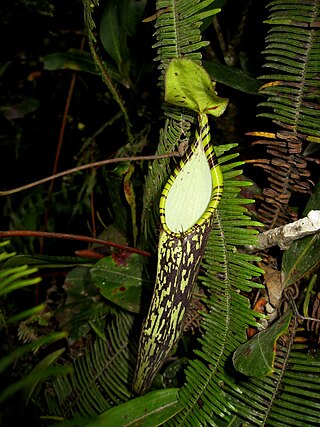
Nepenthes spectabilis is a tropical pitcher plant endemic to Sumatra, where it grows at elevations of between 1400 and 2200 m above sea level. The specific epithet spectabilis is Latin for "visible" or "notable".

Inga is a genus of small tropical, tough-leaved, nitrogen-fixing trees and shrubs, subfamily Mimosoideae. Inga's leaves are pinnate, and flowers are generally white. Many of the hundreds of species are used ornamentally.
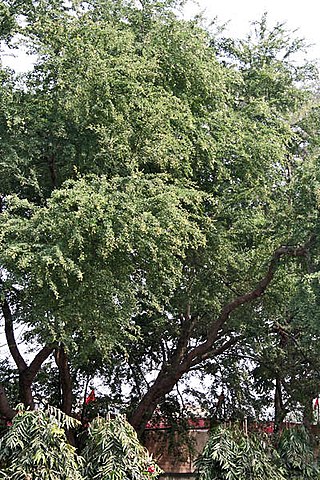
Pithecellobium dulce, commonly known as Manila tamarind, Madras thorn, monkeypod tree or camachile, is a species of flowering plant in the pea family, Fabaceae, that is native to the Pacific Coast and adjacent highlands of Mexico, Central America, and northern South America. It is also sometimes known as monkeypod, but that name is also used for several other plants, including Samanea saman. It is an introduced species and extensively naturalized in the Caribbean and Florida, as well as the Philippines and Guam via the Manila galleons. It has also been introduced to Cambodia, Thailand and South Asia, It is considered an invasive species in Hawaii.

Galearis spectabilis, commonly known as showy orchis or showy orchid, is an orchid species of the genus Galearis. It is native to eastern Canada and much of the eastern half of the United States. In america they are found from eastern Oklahoma north to eastern South Dakota in the west and from Atlanta, Georgia and North Alabama north up into Maine to the east.

Eurybia spectabilis, commonly known as the eastern showy aster, simply showy aster or purple wood aster, is an herbaceous perennial native to the eastern United States. It is present along the coastal plain of the U.S. where it is most often found growing in dry, sandy soils. Although it is not considered threatened due to its extensive range, it is locally endangered in many states. The flowers appear in the fall and show ray florets that are a violet-purple and yellow disc florets. It is one of the parent species of the hybrid Eurybia × herveyi.

The banner-tailed kangaroo rat is a species of rodent in the family Heteromyidae. It is found in arid environments in the southwestern United States and Mexico where it lives in a burrow by day and forages for seeds and plant matter by night.

Inga edulis, known as ice-cream bean, ice-cream-bean, joaquiniquil, cuaniquilguama or guaba, is a fruit native to South America. It is in the mimosoid tribe of the legume family Fabaceae. It is widely grown, especially by Indigenous Amazonians, for shade, food, timber, medicine, and production of the alcoholic beverage cachiri. It is popular in Peru, Ecuador, Pernambuco-Brazil, Venezuela, Guyana and Colombia. The taxonomic name Inga is derived from its name with the Tupí people of South America (ingá) while the species name edulis is Latin for "edible". The common name "ice-cream bean" alludes to the sweet flavor and smooth texture of the pulp.

Malus spectabilis is a species of crabapple known by the common names Asiatic apple, Chinese crab, HaiTang and Chinese flowering apple.
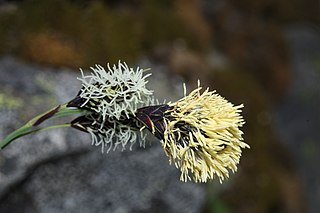
Carex spectabilis is a species of sedge known by the common name showy sedge.
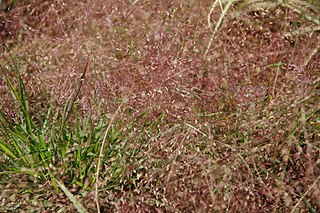
Eragrostis spectabilis, known as purple lovegrass, is a species of flowering plant in the family Poaceae, native from southern Canada to northeastern Mexico. It was first described by Frederick Traugott Pursh in 1813 as Poa spectabilis, and transferred to Eragrostis by Ernst von Steudel in 1840.

Solidago spectabilis is a species of goldenrod known by the common names Nevada goldenrod, basin goldenrod, and showy goldenrod. It is native to the western United States in the Great Basin and surrounding areas. It is found in California, Arizona, Nevada, Oregon, and Utah. There are historical records saying it once grew in southwestern Idaho, but is now extirpated there. This variety has also been seen in the western Montana county of Sanders.

Osmunda spectabilis, known as American royal fern, is a species of fern native to a large area of the New World, from the eastern half of Canada and the United States to Argentina.
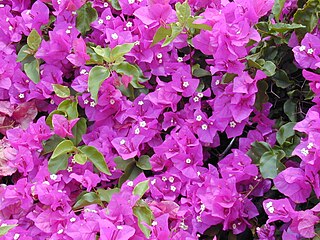
Bougainvillea spectabilis, also known as great bougainvillea, is a species of flowering plant. It is native to Brazil, Bolivia, Peru, and Argentina's Chubut Province. It is widely grown as an ornamental plant.


















